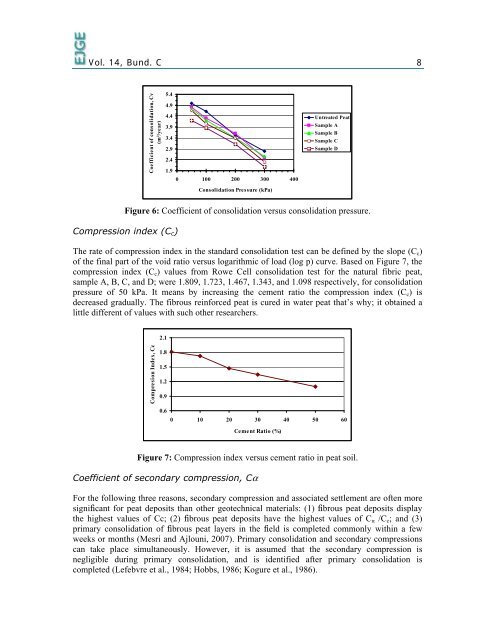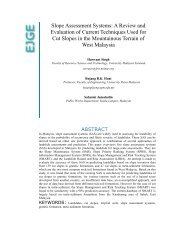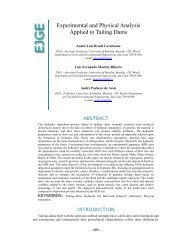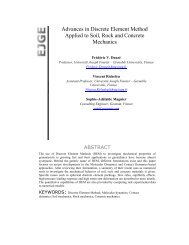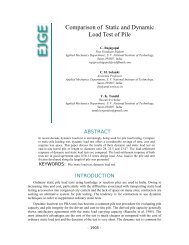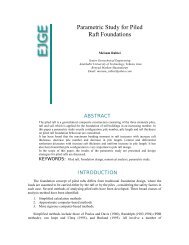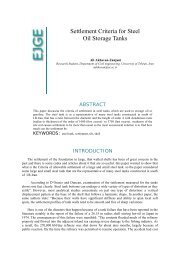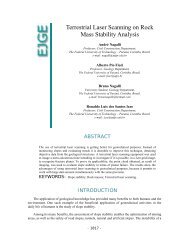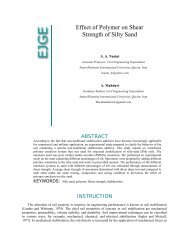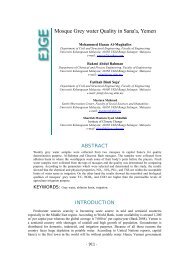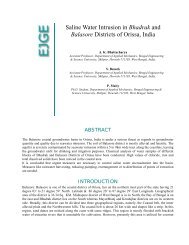Compressibility Characteristics of Fibrous Tropical Peat ... - Ejge.com
Compressibility Characteristics of Fibrous Tropical Peat ... - Ejge.com
Compressibility Characteristics of Fibrous Tropical Peat ... - Ejge.com
You also want an ePaper? Increase the reach of your titles
YUMPU automatically turns print PDFs into web optimized ePapers that Google loves.
Vol. 14, Bund. C 8<br />
Coefficient <strong>of</strong> consolidation, Cv<br />
(m²/year)<br />
5.4<br />
4.9<br />
4.4<br />
3.9<br />
3.4<br />
2.9<br />
2.4<br />
1.9<br />
0 100 200 300 400<br />
Consolidation Pressure (kPa)<br />
Untreated <strong>Peat</strong><br />
Sample A<br />
Sample B<br />
Sample C<br />
Sample D<br />
Figure 6: Coefficient <strong>of</strong> consolidation versus consolidation pressure.<br />
Compression index (C c )<br />
The rate <strong>of</strong> <strong>com</strong>pression index in the standard consolidation test can be defined by the slope (C c )<br />
<strong>of</strong> the final part <strong>of</strong> the void ratio versus logarithmic <strong>of</strong> load (log p) curve. Based on Figure 7, the<br />
<strong>com</strong>pression index (C c ) values from Rowe Cell consolidation test for the natural fibric peat,<br />
sample A, B, C, and D; were 1.809, 1.723, 1.467, 1.343, and 1.098 respectively, for consolidation<br />
pressure <strong>of</strong> 50 kPa. It means by increasing the cement ratio the <strong>com</strong>pression index (C c ) is<br />
decreased gradually. The fibrous reinforced peat is cured in water peat that’s why; it obtained a<br />
little different <strong>of</strong> values with such other researchers.<br />
2.1<br />
Compresion Index, Cc<br />
1.8<br />
1.5<br />
1.2<br />
0.9<br />
0.6<br />
0 10 20 30 40 50 60<br />
Cement Ratio (%)<br />
Figure 7: Compression index versus cement ratio in peat soil.<br />
Coefficient <strong>of</strong> secondary <strong>com</strong>pression, Cα<br />
For the following three reasons, secondary <strong>com</strong>pression and associated settlement are <strong>of</strong>ten more<br />
significant for peat deposits than other geotechnical materials: (1) fibrous peat deposits display<br />
the highest values <strong>of</strong> Cc; (2) fibrous peat deposits have the highest values <strong>of</strong> C α /C c ; and (3)<br />
primary consolidation <strong>of</strong> fibrous peat layers in the field is <strong>com</strong>pleted <strong>com</strong>monly within a few<br />
weeks or months (Mesri and Ajlouni, 2007). Primary consolidation and secondary <strong>com</strong>pressions<br />
can take place simultaneously. However, it is assumed that the secondary <strong>com</strong>pression is<br />
negligible during primary consolidation, and is identified after primary consolidation is<br />
<strong>com</strong>pleted (Lefebvre et al., 1984; Hobbs, 1986; Kogure et al., 1986).


